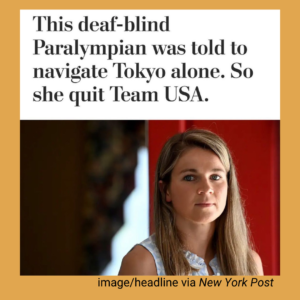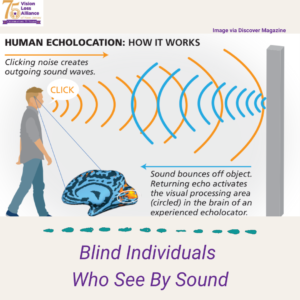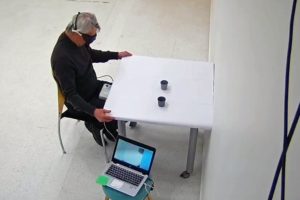Athlete Quits Team USA After She’s Told She Can’t Bring A Care Assistant
Becca Meyers, a six-time Paralympic medalist who is deaf and blind, will miss the Tokyo Paralympics after being told she could not bring her Personal Care Assistant — her mother, Maria Meyers — to the Summer Games.
She called her decision to quit Team USA “gut-wrenching, and wrote: “So, in 2021, why as a disabled person am I still fighting for my rights?”

An image of Becca Meyers is depicted with the headline: “This deaf-blind Paralympian was told to navigate Tokyo alone. So she quit Team USA. Image/headline via New York Post.”
As Meyers has stated of being deaf and blind, “We must continue to fight and advocate for ourselves so that future generations can have an easier tomorrow.” Accessibility matters, inclusion matters, and disability rights matter. Read more about Becca’s story here.
Human Echolocation: How It Works

The VLANJ logo and an image via Discover Magazine depicting how human echolocation works is featured, with text that reads: “Human Echolocation: How It Works. Clicking noise creates ongoing sound waves. Sound bounces off object. Returning echo activates the visual processing area (circled) in the brain of an experienced echolocator.” Text below reads: “Blind Individuals Who See By Sound.”
Bringing Blind Hockey To Newark
As originally reported by the Morristown Daily Record, Josh Schneider of North Haledon, a member of the New York Metro Blind Hockey Team, organized a learn-to-skate clinic for the visually impaired at the RWJBarnabas Health Hockey House in Newark on Sunday, May 23rd, 2021. Learn more here: dailyrecord.com
Scientists Partially Restored a Blind Man’s Sight With New Gene Therapy
A team of scientists announced Monday that they had partially restored the sight of a blind man by building light-catching proteins in one of his eyes. Their report, which appeared in the journal Nature Medicine, is the first published study to describe the successful use of this treatment.
Click here to learn more: https://www.nytimes.com/2021/05/24/science/blindness-therapy-optogenetics.html?action=click&module=In%20Other%20News&pgtype=Homepage
Our Impact
VLANJ annually serves 1200 people with vision loss and their families.
We provided 871 instructional hours of service through 26 class offerings in 2020.
VLANJ program participants report a 95% satisfaction rate for our virtual classes.
VLANJ was able to translate our live programs and create virtual classes within two weeks of being closed by the Covid-19 Pandemic.
Did you know people with vision loss and blindness can use a smart phone or computer completely independently with the aid of magnification or built-in screen reading technology?


